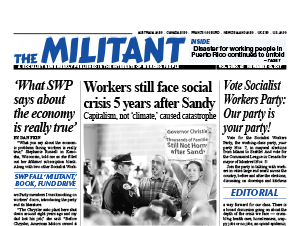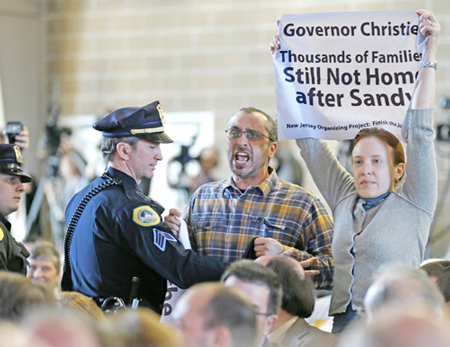“Public housing is still concentrated in the flood plains. Condemned houses are still standing,” Patricia Kane, treasurer of the New York State Nurses Association, told an Oct. 28 Brooklyn climate change protest on the anniversary of Sandy. “New developments are still being built in marsh areas and flood plains. If another super storm were to take place today, we would be no better prepared.”
Kane was working as a nurse at Staten Island Hospital during the storm. Twenty-four of the 43 dead in New York were on Staten Island.
In the face of government inaction, hospital workers took the initiative to go door to door after the storm, Kane said, looking for people who needed medical help.
The social catastrophe workers faced — and many still face — was the product of the workings of the capitalist system, which puts profits before human need.
At first city officials said no evacuations were needed since national weather “experts” predicted that by the time Sandy arrived it would no longer be a full-fledged hurricane, the Washington Post revealed Oct 27. They argued that nursing homes near the water hadn’t flooded when Hurricane Irene hit the year before, so why order a “costly” evacuation now? It was worth taking a chance. For them.
The result — at least 29 nursing homes flooded in Queens and Brooklyn leaving 4,000 nursing home and 1,500 adult home residents without electricity, water, heat or food. It took three days to rescue them.
Like public housing, these facilities were built on low-lying land, regardless of the danger, because it was cheaper.
Mayor Bill de Blasio and Gov. Andrew Cuomo claim that even though it’s five years since Sandy, “we’re” making progress. But nearly 20 percent of the 12,713 families enrolled in the city’s Build It Back program are still waiting for their homes to be rebuilt or raised up above flood level, the New York Daily News reported. More than 11,000 other people who had applied were disqualified or gave up in the face of bureaucratic red tape and delays.
The billions of dollars allocated by government agencies supposedly to be better prepared for future storms have enriched legions of “consultants” and “planners,” as well as some construction bosses and real estate moguls. With little to show for it.
Five years after Sandy, anniversary stories in the press are riddled with reports of anti-flood projects still “in the planning stage” or that “will begin” someday.
Out of 18 major projects to protect public housing that flooded during Sandy — moving generators, electrical controls and heating equipment out of flood-prone basements — only one has been completed.
Metropolitan Transportation Authority Chairman Joseph Lhota has been boasting about advances in preventing a recurrence of the flooding that disabled the subways. The progress? Flood-prevention devices have been installed at less than half the station entrances that need them.
Five years later!
Press accounts point to a lot of talk about floodgates, berms and seawalls to prevent coastal flooding, but few have gone beyond the design stage. There is one that was completed by the Army Corps of Engineers last year — a $28 million project to protect Brooklyn’s Sea Gate, a wealthy gated community, from Coney Island beach erosion.
This social disaster for workers in New York caused by the for-profit values of capitalism is being repeated today in Texas, Florida and in the colonial and semicolonial territories in the Caribbean. Two months after Hurricane Harvey tens of thousands who lost their homes and apartments in Houston are still living in hotels and shelters.
And the catastrophe in Puerto Rico from hurricanes Irma and Maria is a hundred times worse, because it’s a colony of U.S. imperialism. More than a month after the storms, more than 70 percent of the island remains without electricity.
The official death toll in Puerto Rico now stands at 51. But no one really knows. The colonial regime recently admitted it has given permission to funeral homes to cremate the bodies of hundreds who died since the hurricanes hit, while refusing to count any of them as storm-related.
In sharp contrast to the response to the hurricanes in the capitalist U.S. — the richest country on earth — and its colonies, the revolutionary government in Cuba organized working people through their mass organizations to evacuate 1.8 million people in advance of Hurricane Irma. They don’t gamble on people’s lives on the pretext that protecting them is too “costly.”
They didn’t need “consultants” or face red tape from bureaucrats to immediately begin rebuilding homes and repairing the electric grid. Cuban President Raúl Castro explained that the revolution would not “leave anyone on their own.”
Capitalism is to blame
The Oct. 28 “5 Years After Superstorm Sandy” demonstration drew some 1,000 people to march from Brooklyn to Manhattan, and focused its blame for the social calamity resulting from the storm on climate change and workers’ use of fossil fuels.
One marcher told me, “If we don’t stop global warming, it won’t matter if you’re for capitalism or socialism, because it means death of the entire world.”
As part of its broader program, the Socialist Workers Party calls for Washington to unilaterally enforce controls on emissions of carbon dioxide and other greenhouse gases by industry and agribusiness. But hysterical cries that the world is ending or that “global warming” is the cause of the social calamity for working people from recent hurricanes are false and disorient working people.
The social catastrophe from hurricanes Sandy, Irma, Maria and other storms is a result of the capitalist profit system, which is responsible for building on flood plains, the refusal to protect or evacuate nursing homes in low-lying areas, the lack of adequate food and water in shelters and the inability to restore electricity in Puerto Rico.
These questions are addressed in a statement, “The Stewardship of Nature Also Falls to the Working Class: In Defense of Land and Labor,” by SWP leaders Jack Barnes, Steve Clark and Mary-Alice Waters, adopted by a party convention in 2007 and published in New International magazine No. 14.
“So long as the extraction of surplus value in warlike competition for profits dictates the production and distribution of wealth, land will remain private property and rental housing for the toiling majority will be built where the propertied classes don’t want to live. It will be constructed where workers can ‘afford’ the rent, including often on flood plains.”
“The capitalist system, and the propertied families who benefit from it in imperialist centers and semicolonial countries alike, will inevitably continue to ravage humanity and the planet we inhabit,” the SWP leaders say. “It cannot be stopped without uprooting capitalism itself.”
And that’s exactly what workers and farmers in Cuba, led by Fidel Castro and the July 26th Movement, did.
Related articles:
Disaster for working people in Puerto Rico continues to unfold
|
Printer-friendly version of this article |








 click here for information and literature from the Socialist Workers Party 2016 campaign
click here for information and literature from the Socialist Workers Party 2016 campaign a magazine of Marxist politics and theory from 1934 to the present
a magazine of Marxist politics and theory from 1934 to the present an international news magazine published from 1963 to 1986
an international news magazine published from 1963 to 1986 a socialist magazine in Spanish published from 1977 to 2005
a socialist magazine in Spanish published from 1977 to 2005




